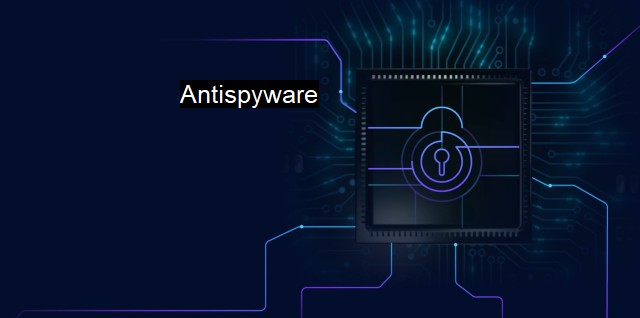What is Antispyware?
Differentiating Antispyware from Antivirus: A Guide to Protecting Your Digital Security
Antispyware is a term that denotes a particular type of software designed to detect, prevent, and remove spyware, a kind of malicious computer software that secretly gathers and shares user information through their internet connection without their consent. Spyware can be installed on a computer without the knowledge or approval of the user and is often used for advertising, surveillance, or theft of personal information. Hence, antispyware software plays a crucial role in providing users with enhanced security, privacy and control over their personal information, in addition to protection for their connected devices.Antispyware applications are specifically designed to scan and monitor all computer processes and files, recognizing and alerting the user about suspicious behavior indicating the presence of spyware. This function is similar to how antivirus software detects and destroys viruses and malware, hence antispyware can be viewed as a form of cybersecurity software, similar to an antivirus program. While the primary objectives of antivirus and antispyware are different, many antivirus programs handle spyware as part of their defense mechanism. antispyware specializes in taking a secondary line of defense to zero in and extinguish this particularly pervasive and invasive kind of threat.
With the rise of internet usage, cyberattacks have become increasingly sophisticated, employing a variety of malware types, including spyware. In this environment, antispyware software has become indispensable for both private users and enterprises alike. Alongside firewalls, intrusion detection and prevention systems, encryption tools, and other cybersecurity tools, antispyware software is used to help create a robust multi-layered defense. Users and corporations are defended against a wide array of intrusions and can maintain the safety of their private information, making sure that identities, financial information, and other confidential data stay well-protected.
Antispyware software leverages signature-based detection, heuristic-based detection, and real-time protection for optimal effectiveness. Signature-based detection involves comparing a file's contents to a signatures database to identify known spyware, while heuristic-based detection uses an algorithm to identify spyware-like behavior. With real-time protection, detection and removal are performed in real-time, preventing any unauthorized activities before they can harm a computer or network.
The user experience Spector is another strength of these tools. They work silently in the background, scanning all activities on a computer while having a negligible impact on system performance, hence, not slowing the system down. If the antispyware software detects a threat, it will either notify the user or take specified actions automatically according to pre-set user preferences. These actions might include quarantining a suspicious file, blocking access to certain domains, preventing download of suspicious attachments, or deleting the detected spyware immediately.
Given the relentless evolution of spyware and the growing sophistication in their modes of attack, it becomes pivotal to ensure that the antispyware software is updated consistently. Regular updates make sure that the software contains the latest spyware definitions, which are crucial to intercept and neutralize emerging threats. it's even more crucial to have this coupled with an updated operating system and web browser, as doing so can maximize the protection power of antispyware technology.
Owing to both the far-reaching capabilities of spyware and subsequently the powerful countermeasures crafted into these antispyware softwares, their significance in the field of cybersecurity cannot be understated. The privacy, integrity, and security of digital information can often hang in the balance, at the mercy of these malicious spywares. As defenders against these insidious programs, antispyware provides a front-line defense by constantly monitoring the cybersecurity horizon and snuffing out hidden threats before they can steal or corrupt sensitive data.
Antispyware is a critical tool in today’s cybersecurity arsenal. As technology advances further remaking everyday life, the threats to personal and organizational safety and privacy present in the virtual world only become larger and far more complex. In the age of information, protecting personal and encrypted data from spyware is a necessity that users and organizations simply cannot risk ignoring. Antispyware software will remain vital in establishing a secure and private digital environment.

Antispyware FAQs
What is antispyware?
Antispyware is software designed to detect, prevent, and remove spyware from a computer system. Spyware is a form of malicious software that can track user activities, steal personal information, and slow down computer performance.How does antispyware work?
Antispyware works by scanning a computer system for any malicious software that may have been installed without the user's knowledge. It then removes any detected spyware and prevents future infections by blocking access to known malicious websites and software.Do I need antispyware software if I already have antivirus?
Yes, you need antispyware software even if you have antivirus because antivirus software mainly focuses on detecting and removing viruses, while antispyware software protects against spyware and other types of malware that antivirus may not detect.What are some features to look for in a good antispyware software?
Some features to look for in good antispyware software include real-time protection, automatic updates, custom scan options, a user-friendly interface, and the ability to detect and remove a wide range of spyware and other malware. Additionally, it's important to choose a reputable and trusted software vendor to ensure maximum protection against cyber threats.| | A | | | B | | | C | | | D | | | E | | | F | | | G | | | H | | | I | | | J | | | K | | | L | | | M | |
| | N | | | O | | | P | | | Q | | | R | | | S | | | T | | | U | | | V | | | W | | | X | | | Y | | | Z | |
| | 1 | | | 2 | | | 3 | | | 4 | | | 7 | | | 8 | | |||||||